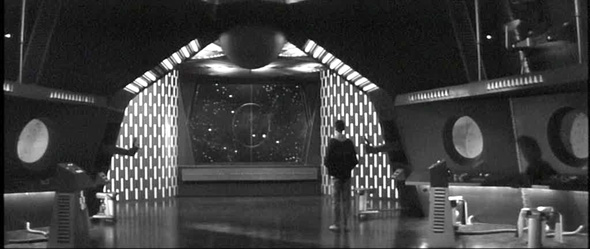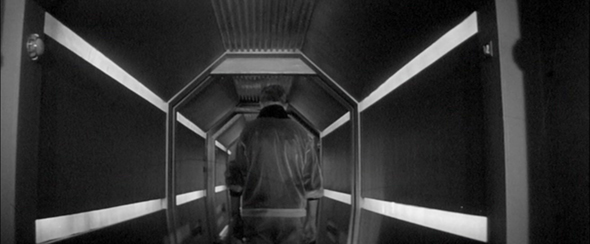
Still frame from Ikarie XB-1 (1963).
In his 1964 philosophical opus Summa Technologiae (the first English translation of which was published by The University of Minnesota Press last year), Polish author Stanisław Lem refers to the SF convention of "space 'ships,' including a brave 'crew'" as symptoms of a kind of "'reverse' nineteenth-century historical novel." "We can surely amuse ourselves like this," Lem wrote, "provided we remember we are only playing."
Lem himself was no stranger to such amusements, using these tropes in fictions such as Tales of Pirx the Pilot (1968) and Oblok Magellana (or "Magellan Nebula," though there appears to have been no English translation), published in 1955. Czech film director Jindřich Polák adapted Oblok Magellana for the screen in 1963 as Ikarie XB-1, which is screening at the New Museum on Sunday in conjunction with the ongoing exhibition "Report on the Construction of a Spaceship Module," for which it is a key design reference.
The depiction of the "space 'ship" in Ikarie XB-1 features premonitions of Kubrick’s 2001: A Space Odyssey (1968), from striated ship backgrounds to an opening sequence where a wounded crewman stumbles through the ship's bowels while pleaded with by what seems to be the Master Computer. Polák uses repetition and churning black-and-white screens to dislocate the viewer, and production designers Jan Zázvorka and Karel Lukas' corridors continue the argument for the Sci-Fi Corridor as a collective work of art.


Still frames from Ikarie XB-1 and 2001: A Space Odyssey.
The film as a whole does not transcend its genre trappings, as Tarkovsky's 1972 adaptation of Lem's masterpiece Solaris (1961) did. But then, Tarkovsky's film was based on a mature work from a writer unconstrained by what the Science Fiction Encyclopedia calls "some of the conventions of 'socialist realism'" apparent in Lem's work before the Polish October. The politics of Ikarie XB1's future are never explicitly addressed, although—as in many shipboard SF fantasies—there is a de facto socialist system with a quasi-military tiered command structure. A crew member's ability to opt out of the mission suggests a decidedly non-totalitarian future; Stalin had, at this point, been dead for eleven years. An encounter with an apparently 20th century American craft whose crew has turned on itself allows for comments on the nature of capitalists: "Vultures!," "Human trash!" etc. The ending recreates the scenario aboard the Ikarie, with the aforementioned wounded crewman attempting to "save" himself using violence. The peaceful resolution was surely read as a caricature of the difference between Soviet and American ethos, but suggests a future beyond the vicious squabbling of the 20th Century. Ikarie XB1, for all its mid-century kitsch and limited aspirations, proves a very serious kind of play.
Ikarie XB-1 serves as a central design inspiration for the New Museum installation, "Report on the Construction of a Spaceship Module," on view through April 6. A specific constellation of tranzit directors worked on this exhibition: Vít Havránek, Director of tranzit in Prague, Dóra Hegyi, Director of tranzit in Budapest, and Georg Schöllhammer, Director of tranzit in Vienna. The exhibition was organized by Lauren Cornell, Curator, 2015 Triennial, Museum as Hub, and Digital Projects. An English-subtitled 82 minute cut of the film is available on The Internet Archive, though it appears to retain the rather silly last shot created for the US/UK edition, retitled Voyage to the End of the Universe. The original 86-minute cut will be screened at The New Museum on Sunday, January 26th as part of a two-day symposium connected with the exhibition.
Thanks to H W Wessells for help in (not) tracking down an English translation of Oblok Magellana.
Disclosure: Rhizome is an affiliate of the New Museum.